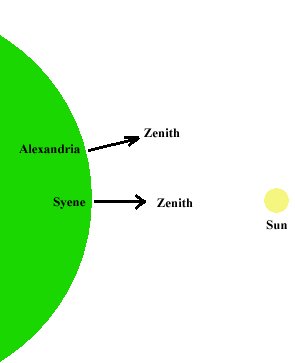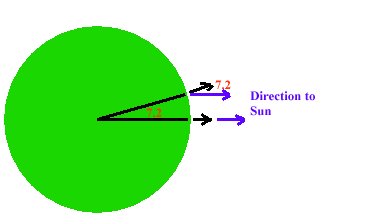
 |
The location of the Sun as seen from the two locations in Egypt. At Syene, the Sun is at the zenith at noon, while at Alexandria it is not exactly overhead. |
While this is sort of neat, what use is it? Well, Eratosthenes
first determined how much difference there was in the Sun's location as
viewed from the two locations. Since the Sun was at the zenith at
Syene, that means it was 90 degrees above the ground. At Alexandria
it was only 82.8 degrees above the ground - this gives and angle difference
of 7.2 degrees in the Sun's location for the two cities. So what
good is that? Well one of the neat things about geometry is how some
angles can pop up over and over under the right circumstances. Just
take a look at the image below. The difference in the zenith and
the Sun's direction at Alexandria is 7.2 degrees. This is also the
difference between the latitudes of Syene and Alexandria.
| The angles that show how the Sun's location varies and the latitude difference of the two locations is actually the same value! |  |
Since there are 360 degrees in a circle, 7.2 degrees is 1/50 of an entire circle. So the span between Syene and Alexandria corresponds to 1/50 of the way all the way around the Earth. There are about 800 km between Syene and Alexandria, so that means there are 50 x 800 = 40,000 km all the way around the Earth. This number is very close to the actual circumference of the Earth, 40,100 km. So by just relating the angular difference to the difference in km, you can measure the size of the Earth pretty easily.
For those of you who are more mathematically minded, it is just a bunch of ratios. The ratio of the angle difference between the two locations compared to the entire number of degrees all the way around the Earth (360) has to equal the ratio of the distance between the two places and the entire circumference of the Earth. This can be mathematically written as